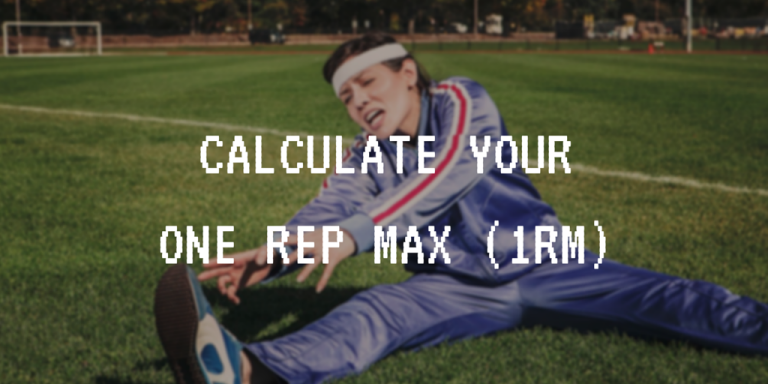You can measure strength in many different ways but the king of them all is the One Repetition Max (1RM) – how much weight you can maximally lift for one full repetition.
The most accurate way to know your 1RM is to actually get under a barbell and test it. However, that could also screw with your program and slow your progress, because of how it taxes your body.
Instead you can use this calculator to estimate your 1RM:
Enter your numbers above
Why would you want to know your 1RM?
Aside from having a handy answer to the inevitable “so, how much do you bench?” question, there’s two other big reasons – one being for programming and the other for motivation.
Many strength programs use your 1RM as base for the prescribed weights. Mondays might be six reps at 80% of your 1RM, Wednesdays ten reps at 70%, etc. Then you’ll have to know your 100%.
The other reason is less practical but important nonetheless. As strength is the base of all athleticism, knowing that yours increases over time will keep you motivated and going in the direction.
The formulas #
There are many different formulas to estimate your 1RM, all with slightly different calculations. The most popular (and proven accurate1) one is the Brzycki formula from Matt Brzycki:
weight / ( 1.0278 – 0.0278 × reps )
If you just managed to lift 100 kg for five reps, you’d calculate your 1RM like this:
100 / ( 1.0278 - 0.0278 × 5 ) = 112.5 kg
You can continue lifting your five reps, if that’s your program, while still getting an idea of where your max strength is at. For me, a chronic 1RM testaholic, this has done wonders for my progression!
The further away from one repetition you are, however, the more unreliable the 1RM estimation will be2. Say you can lift 10 kg for 30 reps – with Brzycki’s formula your 1RM would then be 52 kg. The confidence of this number, however, is so weak it’s not even worth doing the calculation.
As a rule of thumb, never bother for anything above ten repetitions2. For planning purposes, know that your result will normally fall within 5 kg, more or less, of your true 1RM3 4.
Making a formula #
To create these formulas, researchers gather up a bunch of participants, measure some variables, and then crunches numbers to arrive at a formula. Simple, huh?
The measuring can vary a bit between studies but usually participants at least have their different RMs (10RM, 7RM, etc) tested. In some more advanced studies5 they also measure biometric values, like arm length for bench press, body fat, chest circumference, etc.
Anything that the researchers believe can be useful for the final 1RM formula is tested.
Then they apply regression analysis to the gathered numbers. This shows relations between the data, like “a higher 5RM seems to be related to a higher 1RM” or “people with shorter arms seem to be stronger in the bench”. By tweaking the strength of these relations, a formula is born.
Once they have a formula, the researchers can then be test it on the same group of people or, in the case of one study6, another group, to check how accurate the formula is.
One interesting variable for 1RM prediction is the speed of the bar. Mark Rippetoe says in his book Starting Strength to use your eyes to gauge when the bar slows down, as this means you’re starting to get to a heavy weight (closer to your 1RM). Science supports this7 and there’s even a 1RM formula that uses bar speed8. Unfortunately it’ll be tricky to measure the bar speed yourself when lifting.
Most participants in these studies have been men, for whatever reason, but one separate study showed that the resulting formulas seem to hold true even for women9.
Popular formulas #
There are many more than one way to calculate your 1RM. These are the formulas I’ve found:
- Brzycki:
weight × (36 / (37 - reps))(another way to write it) - Epley:
weight × (1 + 0.0333 × reps) - Lander:
(100 × weight) / (101.3 - 2.67123 × reps) - Lombardi:
weight × reps ^ 0.1 - Mayhew et al.:
(100 × weight) / (52.2 + (41.9 × e-0.055 × reps)) - O’Conner et al.:
weight × (1 + 0.025 × reps) - Wathan:
(100 × weight) / (48.8 + (53.8 × e ^ -0.075 × reps))
Testing your True 1RM #
Estimation’s all well and good but what if you want to know what your True 1RM is? Then there’s really no substitute to growing a spine, getting under the bar, and pushing yourself to your limit.
Obviously this will tax your body harder than regular training, so recovery will be longer.
Make sure you have security in place – safety pins, saw horses, or spotters. Especially for the bench press where you can’t bail as easily as with the squat or overhead press.
Don’t jump straight to your 1RM attempt but build up to it gradually. This will both warm yourself up and help your body prepare for the weight. Don’t worry about burning out on the way, you’ll actually be able to lift more this way. Just rest plenty in between lifts once it’s getting heavy.
Finally, know the movement’s rules. If you want to measure your True 1RM, you can’t stop above parallel in a squat, fail to touch your chest in a bench press, or drop the bar when deadlifting.
Train or test #
When you’re in the gym you can either train or test.
Both are useful: training for making progress and testing for evaluating that progress. I say try to avoid testing altogether – for example by calculating an estimation of your 1RM instead.
Personally I haven’t tested at all for eight months now, as of this writing. But by predicting my 1RM I’ve seen it go up and so I’m super motivated by that progress!
In summary – train more than you test.
- Reliability of 1-Repetition Maximum Estimation for Upper and Lower Body Muscular Strength Measurement in Untrained Middle Aged Type 2 Diabetic Patients↩
- Prediction of one repetition maximum strength from multiple repetition maximum testing and anthropometry.↩
- Prediction of 1 repetition maximum in high-school power lifters.↩
- NFL-225 test to predict 1RM bench press in NCAA Division I football players.↩
- Development of 1RM Prediction Equations for Bench Press in Moderately Trained Men.↩
- Establishment of the Prediction Equations of 1RM Skeletal Muscle Strength in 60- to 75-Year-Old Chinese Men and Women.↩
- Velocity- and power-load relationships of the bench pull vs. bench press exercises.↩
- Estimations of One Repetition Maximum and Isometric Peak Torque in Knee Extension Based on the Relationship Between Force and Velocity.↩
- Accuracy of prediction equations for determining one repetition maximum bench press in women before and after resistance training.↩


